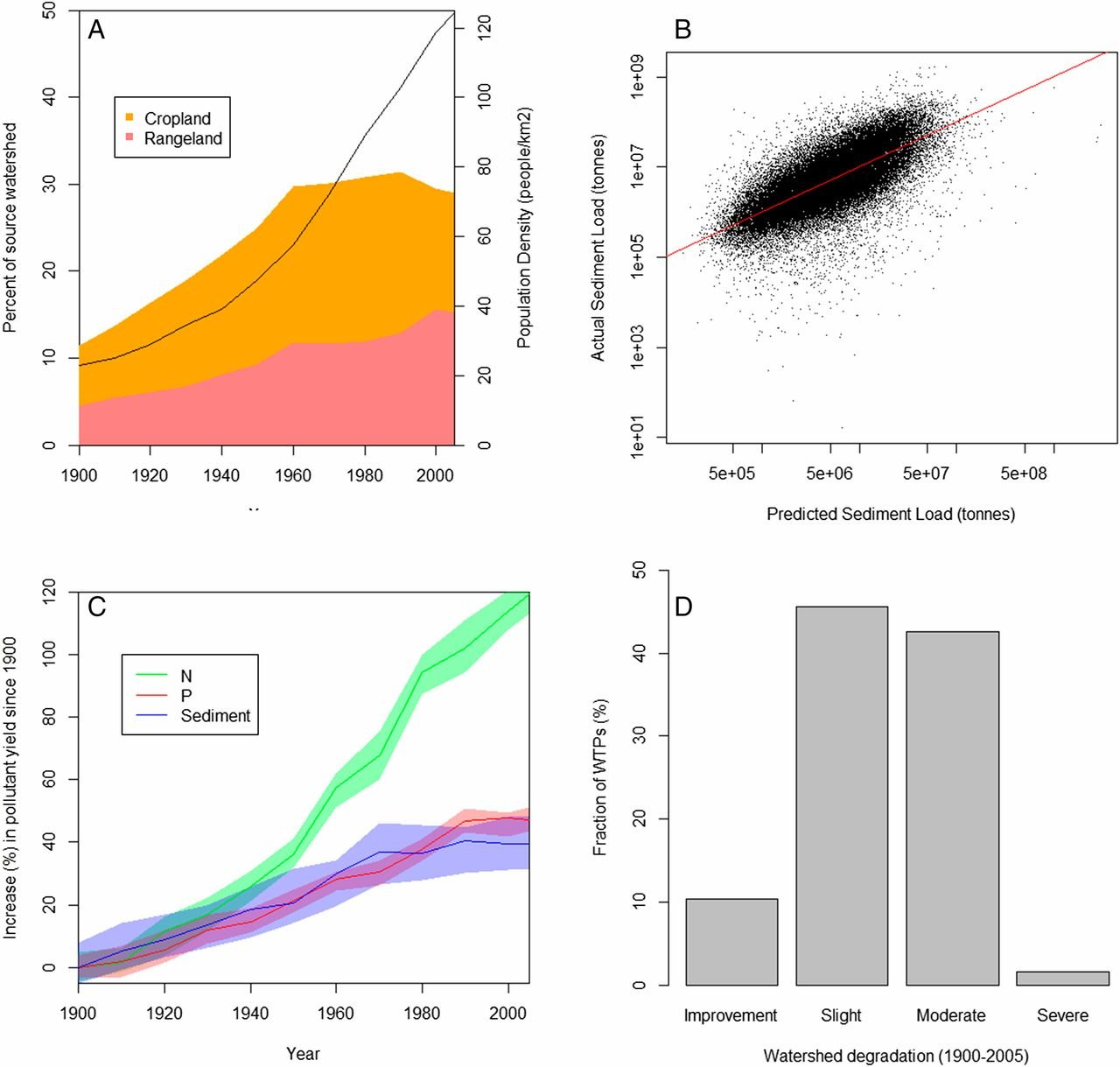文章信息:Robert I. McDonald, Katherine F. Weber, Julie Padowski, Tim Boucher, Daniel Shemie. (2016). Estimating watershed degradation over the last century and its impact on water-treatment costs for the world’s large cities.Proceedings of theNational Academy of Sciences, 113(32):201605354.https://doi.org/10.1073/pnas.1605354113.
整理人:杨文
整理时间:2024年5月16日
Abstract:Urban water systems are impacted by land use within their source watersheds, as it affects raw water quality and thus the costs of water treatment. However, global estimates of the effect of land cover change on urban water-treatment costs have been hampered by a lack of global information on urban source watersheds. Here, we use a unique map of the urban source watersheds for 309 large cities (population > 750,000), combined with long-term data on anthropogenic land-use change in their source watersheds and data on water-treatment costs. We show that anthropogenic activity is highly correlated with sediment and nutrient pollution levels, which is in turn highly correlated with treatment costs. Over our study period (1900-2005), median population density has increased by a factor of 5.4 in urban source watersheds, whereas ranching and cropland use have increased by a factor of 3.4 and 2.0, respectively. Nearly all (90%) of urban source watersheds have had some level of watershed degradation, with the average pollutant yield of urban source watersheds increasing by 40% for sediment, 47% for phosphorus, and 119% for nitrogen. We estimate the degradation of watersheds over our study period has impacted treatment costs for 29% of cities globally, with operation and maintenance costs for impacted cities increasing on average by 53 ± 5% and replacement capital costs increasing by 44 ± 14%. We discuss why this widespread degradation might be occurring, and strategies cities have used to slow natural land cover loss.
摘要:城市供水系统受到其源流域内土地利用的影响,因为它影响原水的质量,从而影响水处理的成本。然而,由于缺乏关于城市水源流域的全球信息,对土地覆盖变化对城市水处理成本影响的全球估计受到了阻碍。在此,我们使用了309个大城市(人口> 75万)的城市源流域的独特地图,并结合了其源流域人为土地利用变化的长期数据和水处理成本数据。我们发现,人为活动与沉积物和营养物污染水平高度相关,而沉积物和营养物污染水平又与处理成本高度相关。在我们的研究期间(1900-2005年),城市源流域的人口密度中位数增加了5.4倍,而牧场和农田利用分别增加了3.4倍和2.0倍。几乎所有(90%)的城市源流域都出现了一定程度的流域退化,城市源流域的平均污染物产出量泥沙增加40%,磷增加47%,氮增加119%。我们估计,在我们的研究期间,流域退化已经影响了全球29%的城市的处理成本,受影响城市的运营和维护成本平均增加了53±5%,重置资本成本增加了44±14%。我们讨论了这种大范围退化可能发生的原因,以及城市用来减缓自然土地覆盖损失的策略。
文章亮点:
全球对陆地湾影响的城市水处理费用的变化由于缺乏关于城市水源流域的全球信息而受到阻碍。将309个大城市的城市水源地图和人类土地利用变化的长期数据相结合,分析土地利用变化对城市水源质量的影响。

图 城市水源流域的退化和水质随时间的变化趋势
注:(a)耕地和牧场覆盖率中位数以及人口密度的时间序列。(b)耕地和牧场覆盖率,加上人口密度,预测沉积物负荷。红线是1:1线。氮和磷(未显示)的趋势相似。(C)相对于1900年的平均污染物排放量,估计的污染物排放量随时间的变化。(d)按流域退化程度分列的污水处理厂比例。
原文链接:https://www.pnas.org/doi/10.1073/pnas.1605354113